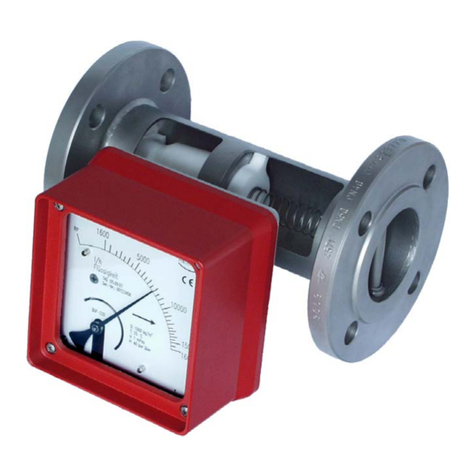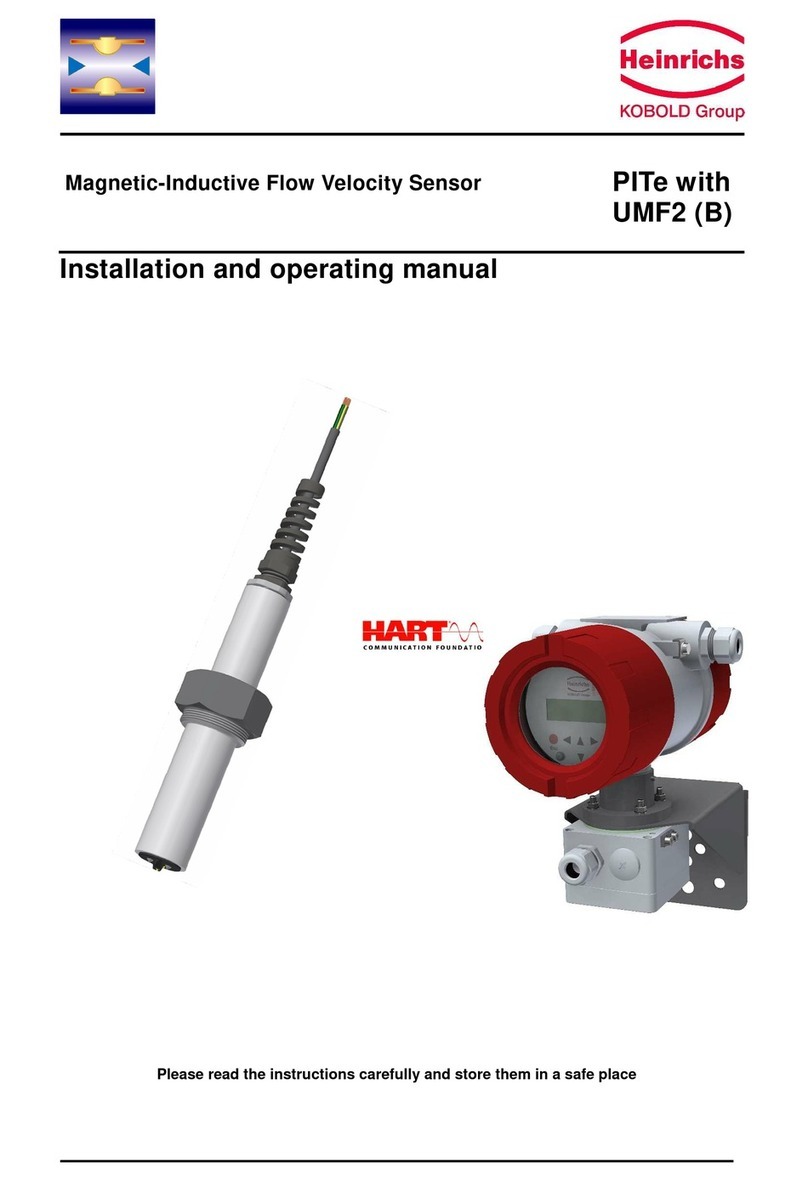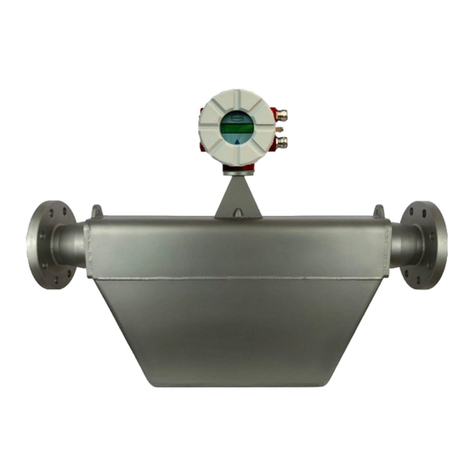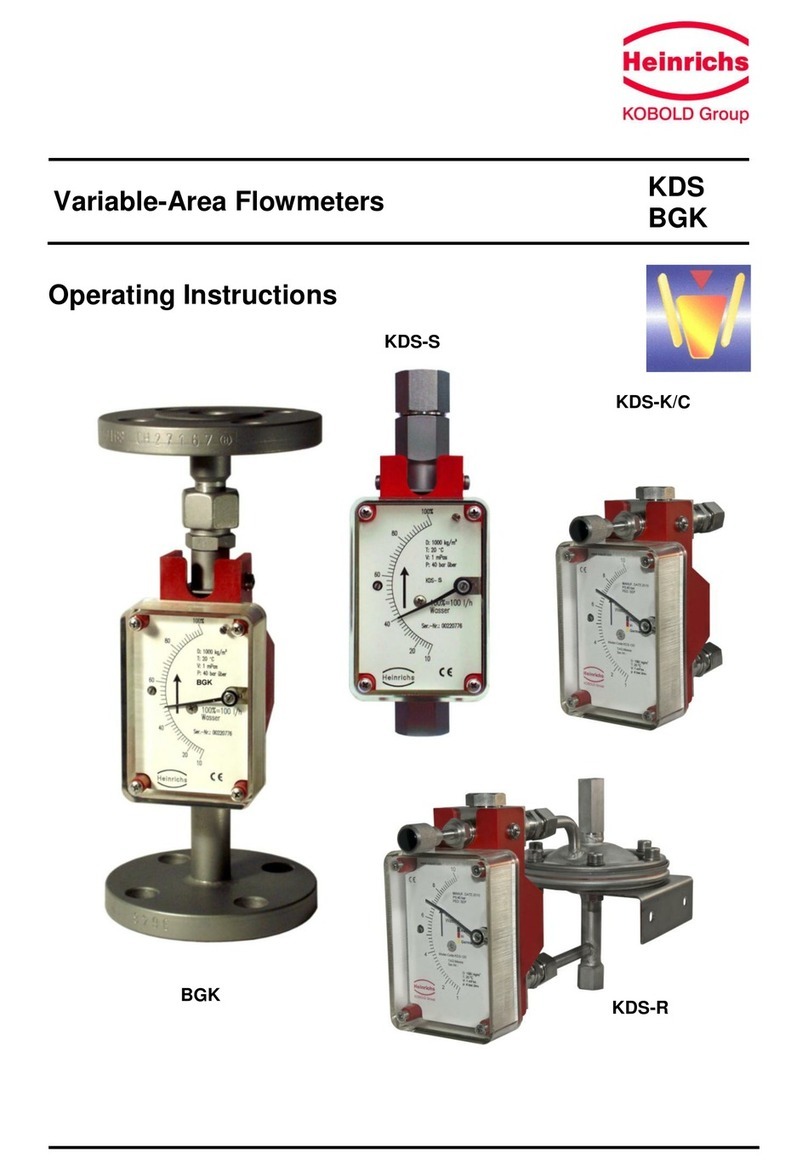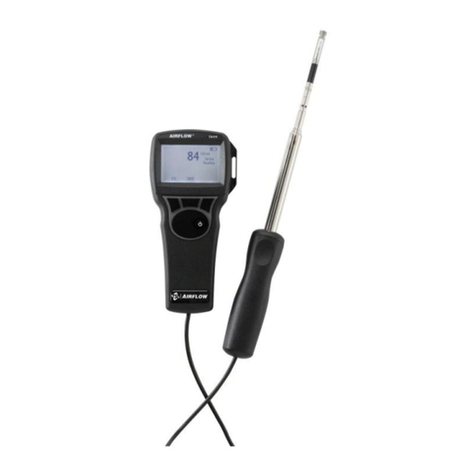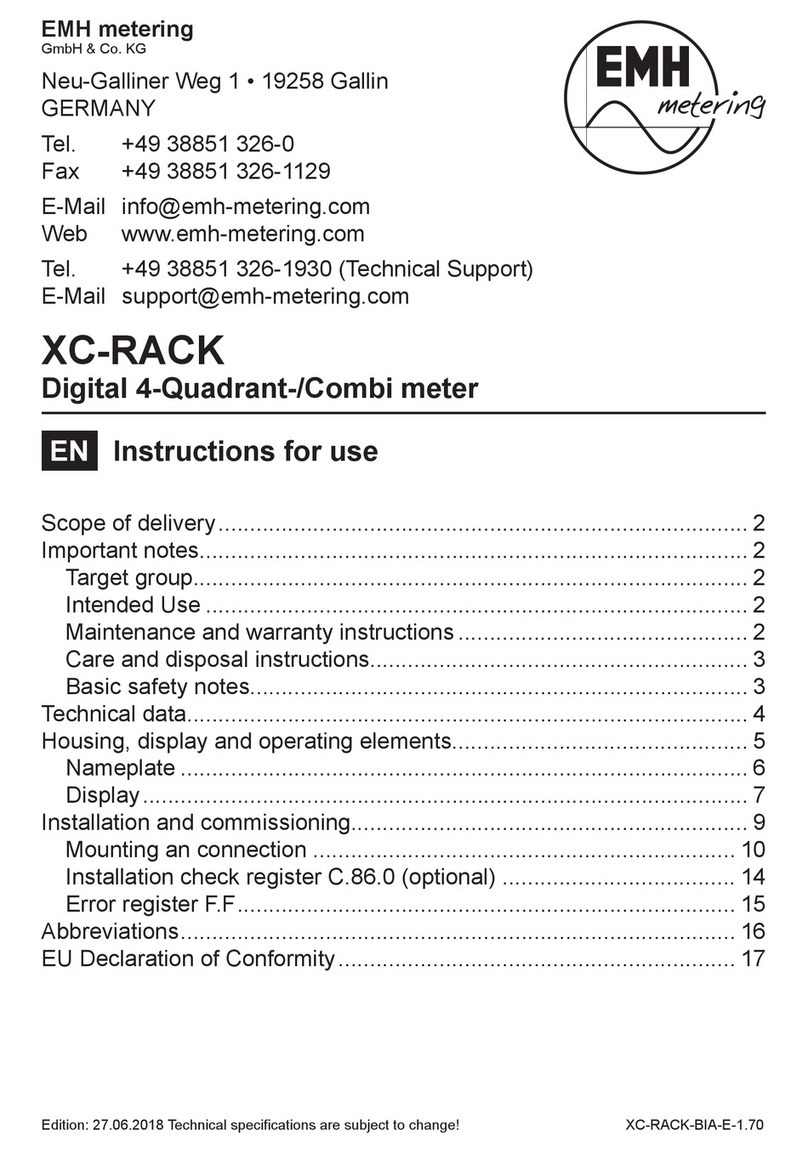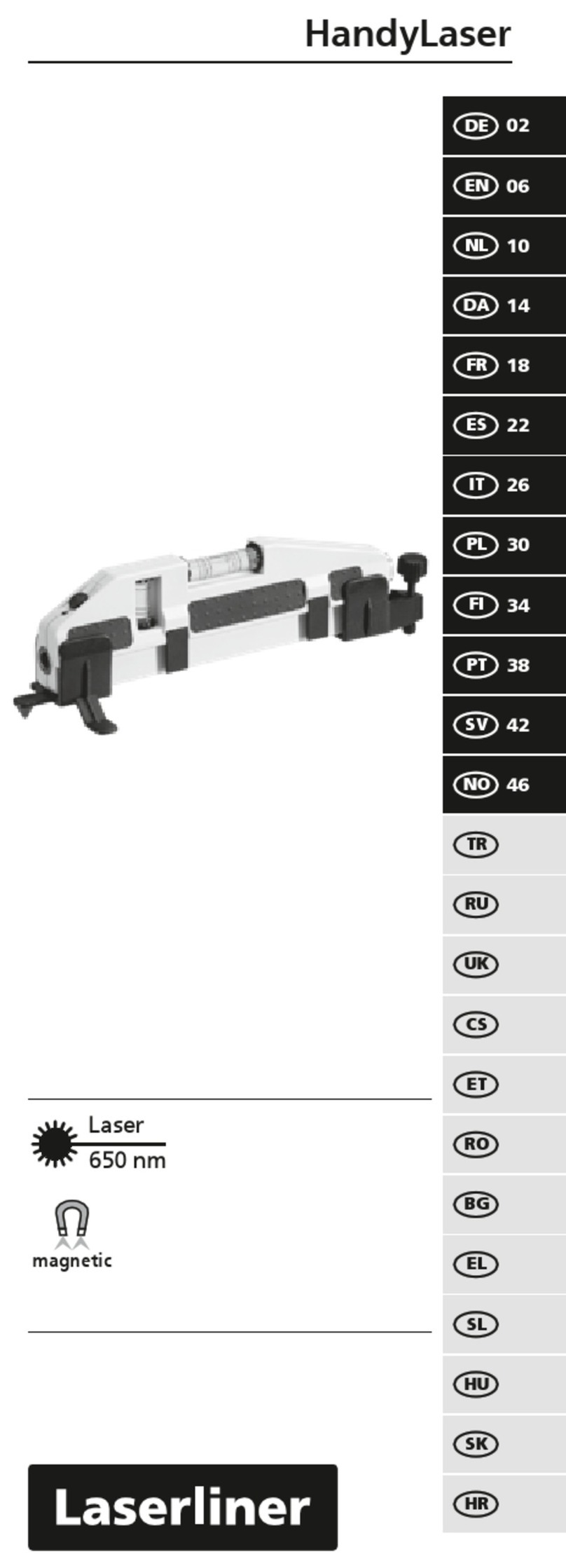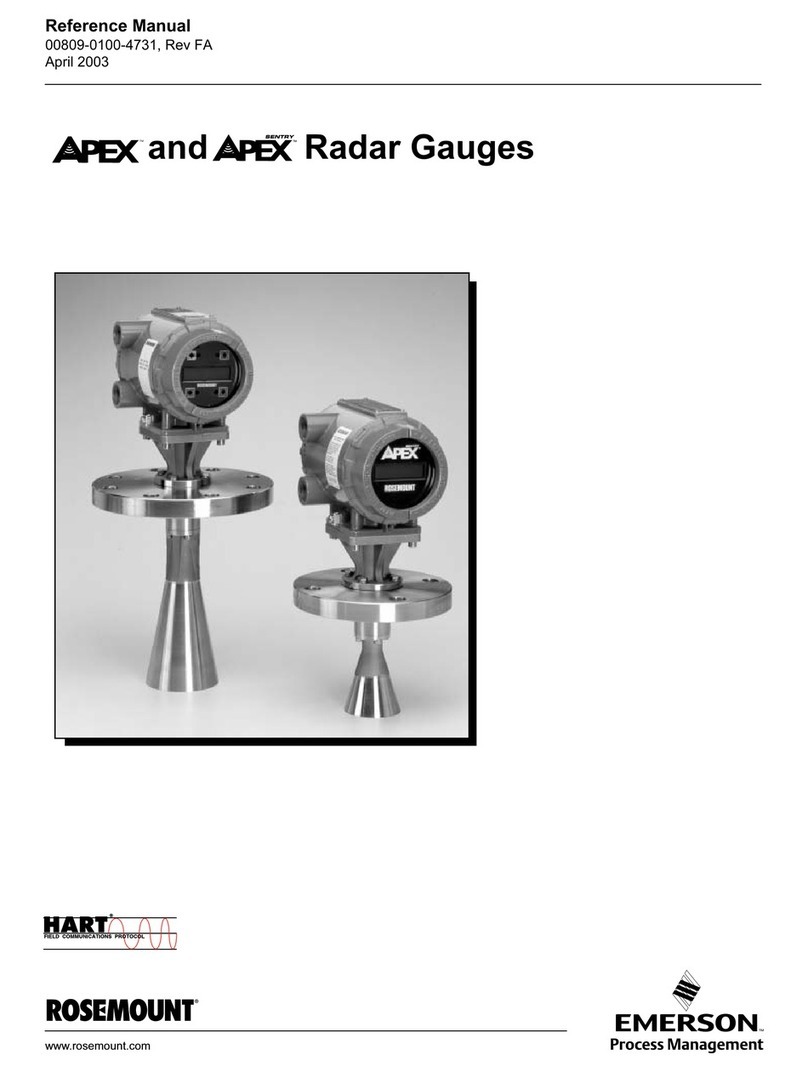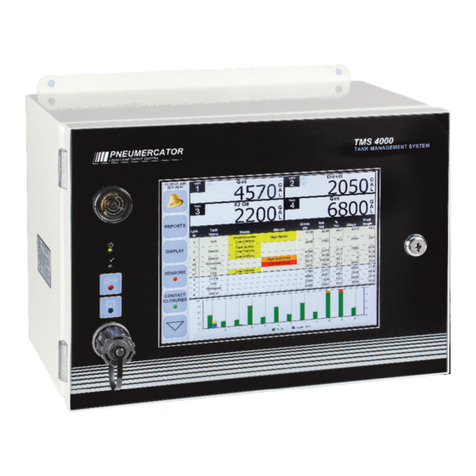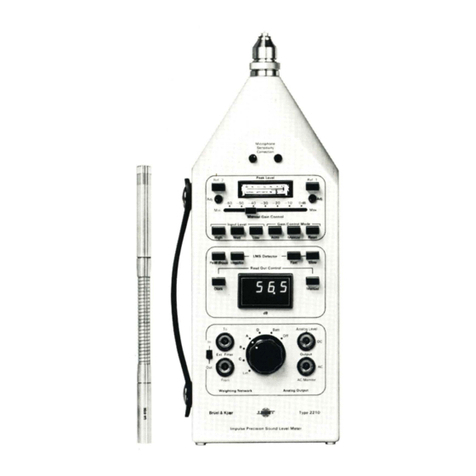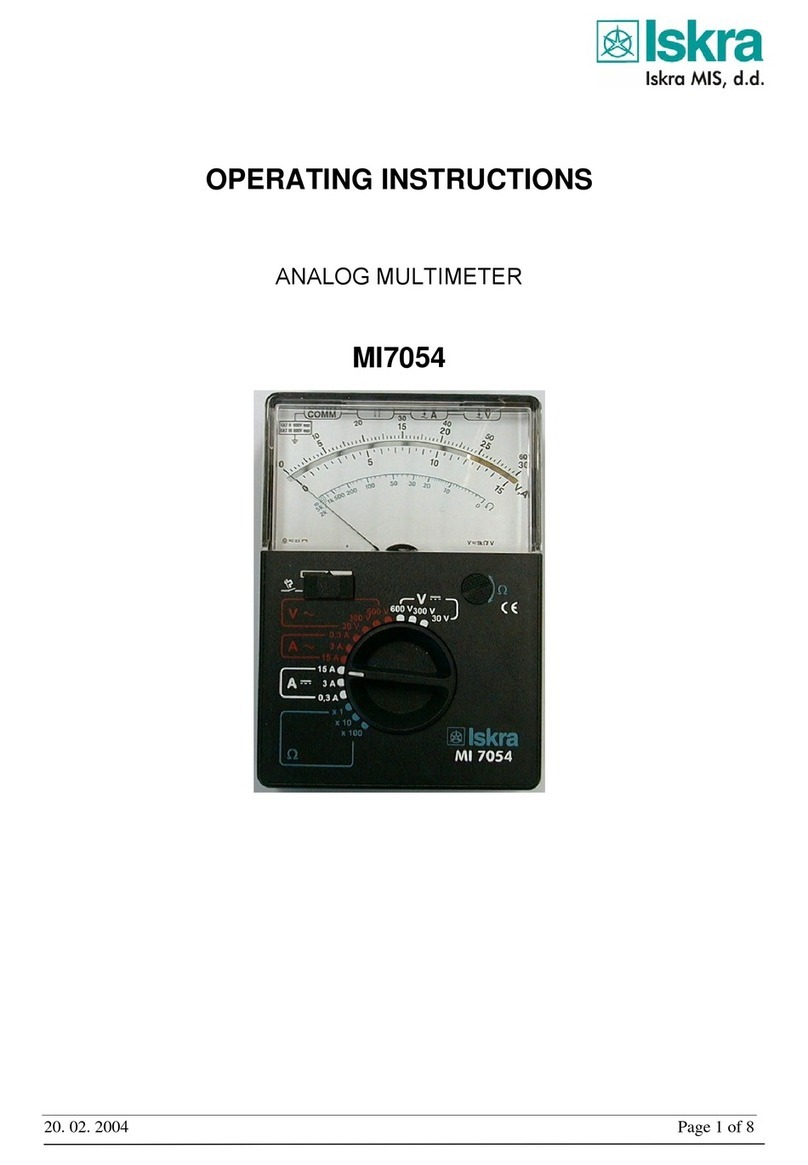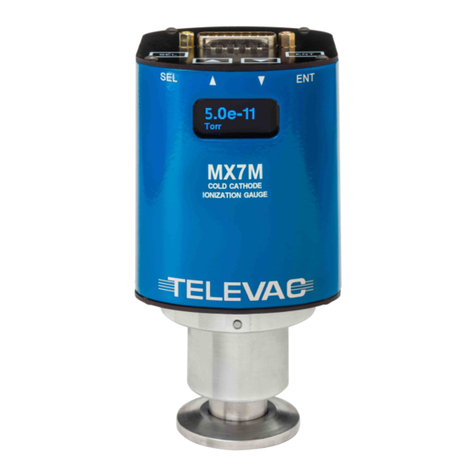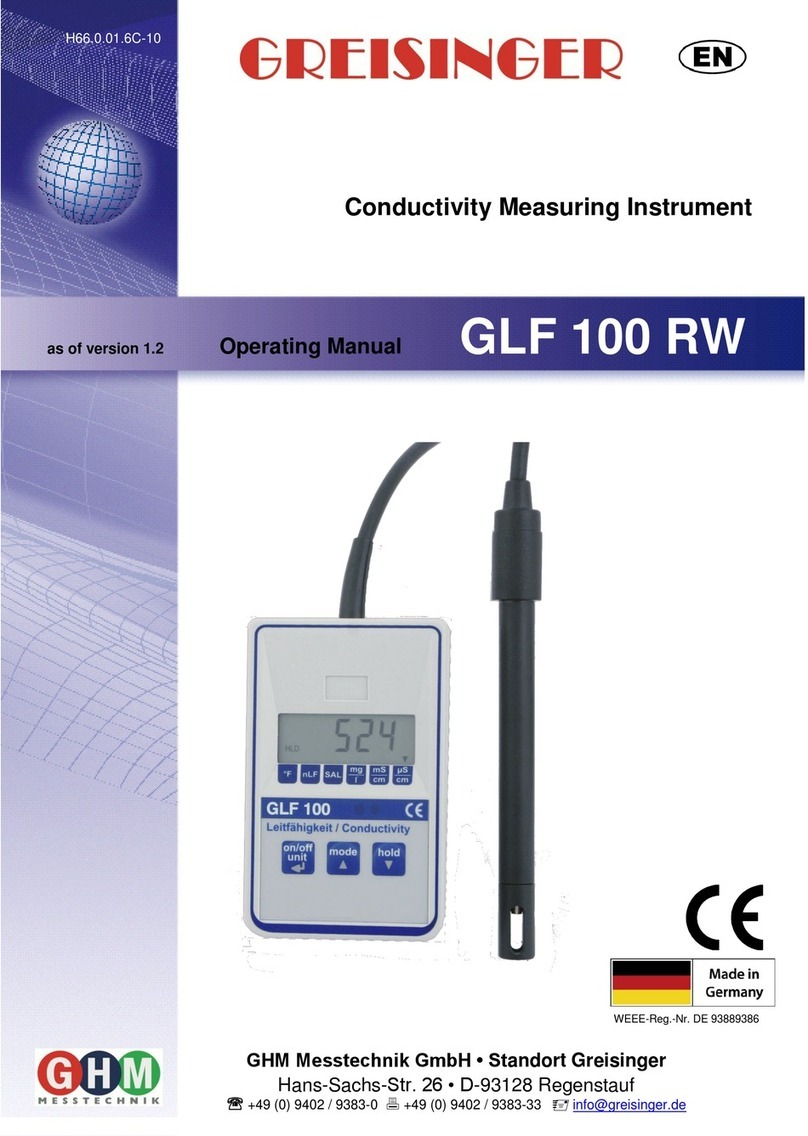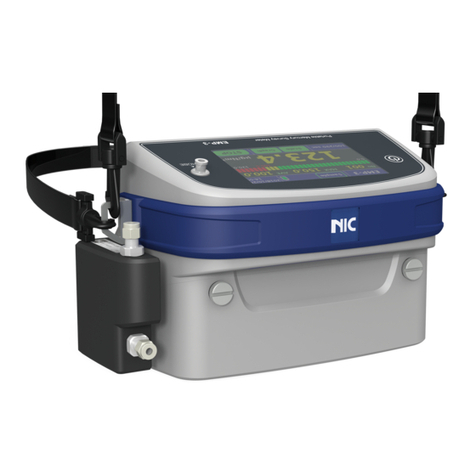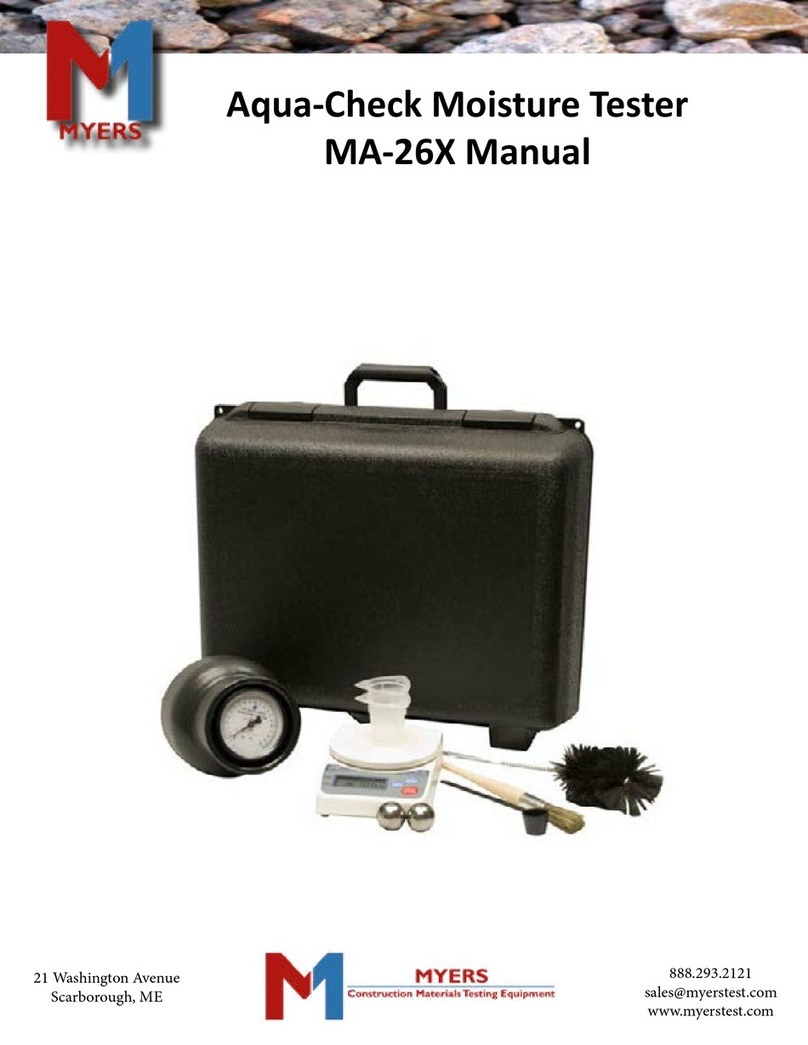Heinrichs UMC4 User manual

Heinrichs Messtechnik GmbH
EX-Supplementary Operating Manual UMC4-TMx
January 2021
Coriolis Mass Flow Meter
UMC4 with
TM, TME,
TMU, TMR
TM-SH
Supplementary Operating Manual for
explosion-proof flow meters
This operating manual contains important information for the operation in potentially explosive atmospheres
Please read the instructions carefully and store them in a safe place for future reference

Heinrichs Messtechnik GmbH
Page 2 of 31
Ex-Supplement operating manual
UMC4 with TM/TMU/TME/TMR/TM-SH
CONTENTS
INTRODUCTION............................................................................................................................................... 4
IShipping and storage; product inspection............................................................................................................................ 4
II Warranty......................................................................................................................................................................................... 4
III Validity of this operating manual ............................................................................................................................................ 4
IV Repairs and hazardous materials ........................................................................................................................................... 4
1. STEPS PRIOR TO OPERATION......................................................................................................... 5
1.1 Installation, mounting, commissioning and maintenance .............................................................................................. 5
1.2 Hazard warnings .......................................................................................................................................................................... 6
1.3 Proper use of the device............................................................................................................................................................ 6
2. IDENTIFICATION .................................................................................................................................. 7
3. GENERAL INFORMATION ABOUT EXPLOSION PROTECTION................................................. 8
4. CORIOLIS MASS FLOW METER ....................................................................................................... 9
4.1 Description of the TM, TME, TMU and TMR sensors ........................................................................................................ 9
4.2 Device identification.................................................................................................................................................................... 9
4.3 Mounting ......................................................................................................................................................................................10
4.3.1 Thermally insulated sensor.......................................................................................................................................10
4.3.2 Heated sensor...............................................................................................................................................................10
4.3.3 Connection sensor –transmitter............................................................................................................................10
4.3.3.1 Sensor Cable Pin Assignment .........................................................................................................................11
4.3.3.2 Cable Parameters ...............................................................................................................................................11
4.3.3.3 Equipotential bonding .......................................................................................................................................11
4.4 EC Type-Examination Certificate for the sensors............................................................................................................12
4.4.1 Sensor Parameters......................................................................................................................................................12
4.4.2 Ambient temperature range Ta ...............................................................................................................................13
4.4.2.1 Conditions for safe operation..........................................................................................................................14
4.5 Description of the UMC4 transmitter ..................................................................................................................................14
4.5.1 Device identification....................................................................................................................................................14
4.5.2 Ignition category of the transmitter.......................................................................................................................14
4.5.3 Connecting cables ........................................................................................................................................................15
4.5.3.1 Sensor circuits .....................................................................................................................................................15
4.5.3.2 Electrical connection of power and signal circuits....................................................................................15
4.5.3.3 Cable and conduit entries.................................................................................................................................16
4.5.3.4 Equipotential bonding .......................................................................................................................................16
4.5.4 Parameters for the UMC4 transmitter..................................................................................................................16
4.5.4.1 Power circuit (terminals L, N and PE)............................................................................................................16
4.5.4.2 Passive non-intrinsically safe circuits ..........................................................................................................16
4.5.4.3 Sensor circuits type of protection Ex ia II ....................................................................................................17
4.5.4.4 Signal output circuits with Ex ia II type of protection ..............................................................................18

Heinrichs Messtechnik GmbH
Ex- Supplement operating manual
UMC4 with TM/TMU/TME/TMR/TM-SH
Page 3 of 31
4.5.4.5 Ambient temperature range Ta .................................................................................................................... 18
5. INSTALLATION AND COMMISSIONING....................................................................................... 19
5.1 Special conditions for safe use for the UMC4................................................................................................................... 19
5.2 General conditions for safe operation................................................................................................................................. 19
5.3 Requirements for installation in all environments.......................................................................................................... 20
5.4 Ex relevant screw and bolt torques ..................................................................................................................................... 20
6. MAINTENANCE AND REPAIR WORK ........................................................................................... 21
6.1 Definition of terms according to IEC 60079-17:.............................................................................................................. 21
7. WARNING NOTICES.......................................................................................................................... 22
8. MODEL CODES .................................................................................................................................. 23
8.1 The Transmitter UMC4............................................................................................................................................................ 23
8.2 The TM Sensor ........................................................................................................................................................................... 24
8.3 The TMU Sensor ........................................................................................................................................................................ 25
8.4 The TME Sensor......................................................................................................................................................................... 26
8.5 The TMR Sensor ........................................................................................................................................................................ 27
8.6 The TM-SH Sensor.................................................................................................................................................................... 28
9. EC DECLARATION OF CONFORMITY............................................................................................ 29

Heinrichs Messtechnik GmbH
Page 4 of 31
Ex-Supplement operating manual
UMC4 with TM/TMU/TME/TMR/TM-SH
Introduction
I Shipping and storage; product inspection
Shipping and Storage
The device is to be safeguarded against moisture, dirt, impact and damage.
Product inspection
Upon receipt of the product, the consignment should be checked for completeness. The data of the device have
to be compared with the packing slip and the order documents
Notify us of any shipping damage immediately upon receipt of the product. Any damage claim received at a
later time will not be honored.
II Warranty
Your flow meter was manufactured in accordance with the highest quality standards and was thoroughly
tested prior to shipment. However, in the event any problem arises with your device, we will be happy to
resolve the problem for you as quickly as possible under the terms of the warranty which can be found in the
terms and conditions of delivery. Your warranty will only be honored if the device was installed and operated in
accordance with the instructions for your device. Any mounting, commissioning and/or maintenance work is to
be carried out by qualified and authorized technicians only.
III Validity of this operating manual
Note! The present instructions apply to explosion-proof Coriolis flow meters
TM/TME/TMU/TMR and TM-SH series which are operated in conjunction with the UMC4
transmitter as of year of construction October 2018 or later.
These instructions are supplementary operating manual for non-explosion proof Coriolis flow
meters. If you do not have a copy of the latter instructions, please request one from Heinrichs Messtechnik
GmbH or download the instructions from our website.
The instructions herein pertain primarily to explosion proof Coriolis flow meters. The technical data in the
mounting and operating instructions for non-explosion proof Coriolis flow meters still apply insofar as the
present instructions do not replace them or exclude their application.
IV Repairs and hazardous materials
It is important that you do the following before shipping your flow meter to Heinrichs Messtechnik GmbH for
repair:
•Enclose a description of the problem with your device. Describe in as much detail as possible the
application and the physical and chemical properties of the fluid.
•Remove any residues from the device and be sure to clean the seal grooves and recesses thoroughly. This
is particularly important if the fluid is corrosive, toxic, carcinogenic, radioactive or otherwise hazardous.
The operator is liable for any substance removal or personal damage costs arising from inadequate cleaning of
a device that is sent for repair.

Heinrichs Messtechnik GmbH
Ex- Supplement operating manual
UMC4 with TM/TMU/TME/TMR/TM-SH
Page 5 of 31
1. Steps prior to operation
Prior to installation and operation, it is essential that the operator familiarizes himself
with all of the instructions and information contained in the manual for non-explosion
proof Coriolis flow meters as well as the present instructions. If any part of either manual
is missing, contact Heinrichs Messtechnik GmbH to request a new manual. These
manuals can also be downloaded from our website.
The UMC4 transmitter described herein is only to be used to measure mass and volume
flow, as well as liquid and gas density and temperature, in conjunction with a Heinrichs Messtechnik GmbH TM,
TME, TMU, TMR or TM-SH sensor.
1.1 Installation, mounting, commissioning and maintenance
Installation, mounting, commissioning and maintenance are to be performed by a technician trained to work
with explosion-proof devices, or by a Heinrichs Messtechnik service technician.
Warning
Any maintenance or repair that safety relevant in terms of explosion-protection is to be
carried out by the manufacturer, an authorized Heinrichs
Heinrichs Messtechnik GmbH accepts no liability for any loss or damage of any kind arising from improper
operation of any product, improper handling or use of any replacement part, or from external electrical or
mechanical effects, overvoltage or lightning. Any such improper operation, use or handling shall
automatically invalidate the warranty for the product concerned.
In the event of a problem please contact the service center of Heinrichs Messtechnik:
Contact our customer service department if your device needs repair or if you need assistance in diagnosing a
problem with your device.

Heinrichs Messtechnik GmbH
Page 6 of 31
Ex-Supplement operating manual
UMC4 with TM/TMU/TME/TMR/TM-SH
1.2 Hazard warnings
The purpose of the hazard warnings listed below is to ensure that device operators and maintenance personnel
are not injured and that the flow meter and any devices connected to it are not damaged.
The safety advisories and hazard warnings in the present document that aim to avoid placing operators and
maintenance personnel at risk and to avoid material damage are prioritized using the terms listed below, which
are defined as follows in regard to the instructions herein and the advisories pertaining to the device itself.
Warning
means that failure to take the prescribed precautions could result in injury, substantial material
damage or even death. Always comply to these warnings and proceed with caution.
Caution
means that failure to take the prescribed precaution could result in material damage or
destruction of the device. We advice always to abide to these instructions!
Note
means that the accompanying text contains important information about the product, handling
the product or about a section of the documentation that is of particular importance.
1.3 Proper use of the device
Warning
The operator is responsible for ensuring that the material used in the sensor and
transmitter housing is suitable and that such material meets the requirements for the fluid
being used and the ambient site conditions. The manufacturer accepts no responsibility in
regard to such material and housing.
Warning
In order for the device to perform correctly and safely, it must be shipped, stored, set up,
mounted operated and maintained properly.

Heinrichs Messtechnik GmbH
Ex- Supplement operating manual
UMC4 with TM/TMU/TME/TMR/TM-SH
Page 7 of 31
2. Identification
Manufacturer:
Heinrichs Messtechnik GmbH
Robert-Perthel-Strasse 9
D-50739 Cologne
Germany
Product type:
Mass flow-rate meter for liquid and gaseous products
Product name:
Sensor type: TM / TMU / TME / TMR / TM-SH
Transmitter type: UMC4
File name:
umc4_ex-ba_21.01_en.doc
Version:.
21.01,
Date, January 31, 2021

Heinrichs Messtechnik GmbH
Page 8 of 31
Ex-Supplement operating manual
UMC4 with TM/TMU/TME/TMR/TM-SH
3. General information about explosion protection
Acc. Directive 94/9/EC (ATEX)
Example designation
0158
II
2G
Ex
ia
IIC
T6
Gb
Equipment groups
I
Equipment group I applies to equipment intended for use in underground
parts of mines as well as those parts of surface installations of such mines
endangered by firedamp and/or combustible dust.
II
Equipment group II applies to equipment intended for use in other places
liable to be endangered by explosive atmospheres. This group is subdivided
into three categories.
Equipment category
Gas
Dust
Definition
1G
(0)
1 D
(20)
Equipment in this category is intended for use in areas in which
explosive atmospheres caused by mixtures of air and gases,
vapours or mists or by air/dust mixtures are present continuously, for
long periods or frequently.
2 G
(1)
2 D
(21)
Equipment in this category is intended for use in areas in which
explosive atmospheres caused by gases, vapours, mists or air/dust
mixtures are likely to occur.
3G
(2)
3D
(22)
Equipment in this category is intended for use in areas in which
explosive atmospheres caused by gases, vapours, mists, or air/dust
mixtures are unlikely to occur or, if they do occur, are likely to do so
only infrequently and for a short period only.
(The numbers in round brackets correspond to the IEC Zones.)
Acc. EN 60079-0 ff / IEC 60079-0 ff
Ex = Explosion-proof electrical equipment
Types of protection
General requirements
IEC 60079-0
„d“
Flameproof enclosure
IEC 60079-1
„e“
Increased safety
IEC 60079-7
„i“
Intrinsic safety (ia, ib)
IEC 60079-11
„t"
Equipment dust ignition protection by
enclosure "t" (ta, tb or tc)
EN 60079-31
Explosion groups
Gases and vapours
IIA
Acetone, benzene, fuel oil, ethanoic acid
IIB
City gas, ethylene, isoprene
IIC
Acetylene, hydrogen, carbon bisulphide
Dust Atmospheres
IIIA
Fibers and flyings
IIIB
Non-conductive dusts
IIIC
Metal dusts
Temperature classes
Maximum surface temperature
Temperature class
450 °C
842 °F
T1
300 °C
572 °F
T2
200 °C
392 °F
T3
135 °C
275 °F
T4
100 °C
212 °F
T5
85 °C
185 °F
T6
Equipment protection level, EPL
Gases: Ga, Gb oder Gc
Dust: Da, Db or Dc
Explosion protection designations [square brackets] refer to “Related electrical equipment or circuits.”

Heinrichs Messtechnik GmbH
Ex- Supplement operating manual
UMC4 with TM/TMU/TME/TMR/TM-SH
Page 9 of 31
4. Coriolis mass flow meter
4.1 Description of the TM, TME, TMU and TMR sensors
The TMU sensor is an “Intrinsic safety” type of protection device that is outfitted with the following four
independent potential-free circuits: These circuits are safely separated in the sensor
Excitation circuit
Sensor circuit 1
Sensor circuit 2
Temperature sensor circuit (PT1000)
If the transmitter is mounted externally, it should be connected to the sensor using a Heinrichs Messtechnik
cable that is specially designed for this purpose.
Although the appearance of the standard and explosion-proof transmitters is identical and their rating plates
contain the same information, under no circumstances should a standard (non-explosion proof) transmitter
be connected to an explosion-proof sensor!
4.2 Device identification
The rating plates on Heinrichs Messtechnik flow meters that are suitable for use in potentially explosive
atmospheres are labeled accordingly. Since the sensor and transmitter have different ratings, each device has
its own rating plate.
TM/TME/TMU/TMR/TM-SH rating plate
Example: TM for process temperatures ranging from - 40 °C to 100 °C.

Heinrichs Messtechnik GmbH
Page 10 of 31
Ex-Supplement operating manual
UMC4 with TM/TMU/TME/TMR/TM-SH
4.3 Mounting
The mounting instructions for the standard sensor also apply to the explosion-proof sensor.
4.3.1 Thermally insulated sensor
The explosion-proof sensor can be outfitted with thermal insulation in potentially explosive atmospheres as
well. However, the insulation should only cover half of the support tube on which the junction box or integrated
transmitter is mounted.
4.3.2 Heated sensor
To avoid crystallization in the flow tubes, the sensor can be externally heated. Any heating technique or device
may be used. By use of electrical heating devices, these must be suitable for use in the potentially explosive
environments.
It is the operator’s responsibility to ensure that the heating temperature does not exceed the maximum
allowable temperature for the fluid and/or the maximum allowable temperature range for the potentially
explosive atmosphere in which the device is being operated.
The maximum allowable temperature range for the fluid is indicated on the flow meter rating plate.
It is also the operator’s responsibility to ensure that no hazards are created by hot surfaces pursuant to
EN 1127-1 (Explosive atmospheres - Explosion prevention and protection) paragraphs 5.2 and 6.4.2.
4.3.3 Connection sensor –transmitter
Compact meters (sensor and transmitter form a unit and are connected electrically)
The electrical connection is made by the manufacturer. Furthermore the proof of the intrinsic safety of the
sensor circuits (according EN 60079-14) was carried out by the manufacturer and ensured. For these circuits no
action is required by the operator.
Remote installation
A dedicated cable SLI2Y (SP) CY 5 x 2 x 0.5 mm² [blue] is to be used for the electrical connection between
sensor and remote mount transmitter. This cable, which is available from Heinrichs Messtechnik, has five
twisted pairs, each of which has a foil shield and filler cord. The filler cords are to be installed on the “shield”
terminal in both the sensor and transmitter. The five twisted wire pairs are themselves shielded by tinned
copper wire mesh. This external cable shield is connected to the housing via a dedicated EMC cable fitting, thus
ensuring optimum noise immunity.
Schirm / shield
10
9
8
5
7
6
4
3
2
1
-
-
-
-
-
-
-
-
-
-
rosa / pink
grau / grey
schwarz / black
violett / violett
blau / blue
rot / red
gelb / yellow
grün / green
weiß / white
braun / brown
-
-
-
-
-
-
-
-
-
-
Schirm / shield
10
9
8
5
7
6
4
3
2
1
rosa / pink
grau / grey
schwarz / black
violett / violett
blau / blue
rot / red
gelb / yellow
grün / green
weiß / white
braun / brown

Heinrichs Messtechnik GmbH
Ex- Supplement operating manual
UMC4 with TM/TMU/TME/TMR/TM-SH
Page 11 of 31
4.3.3.1 Sensor Cable Pin Assignment
Pin Designation
Connection / Pin Assignment
Protection Type
Ex ia
Sensor circuit
Pick-Up1 +
1
x
Pick-Up1 -
2
x
Pick-Up2 +
3
x
Pick-Up2 -
4
x
TIk-
5
x
Temperature Sensor -
6
x
Temperature Sensor +
7
x
TIk+
8
x
Exciter coil +
9
x
Exciter coil -
10
x
Schirm
Schirm
x
4.3.3.2 Cable Parameters
The operator is to comply in all cases with the applicable installation regulations such as EN 60079-14
“Electrical apparatus for explosive gas atmospheres- Part 14: Electrical installations in hazardous areas
The operator is to comply in all cases with the applicable installation regulations such as EN 60079-14
“Electrical apparatus for explosive gas atmospheres- Part 14: Electrical installations in hazardous areas”.
Applicable guidelines pertaining to the interconnection of intrinsically safe circuits must also be observed.
The following maximum values apply to the cable mentioned above:
CL= 100 pF/m wire to wire
CL= 170 pF/m wire to shield
LL= 700 µH/km wire to wire
LL= 500 µH/km wire to shield
Warning
If a connecting cable other than the Heinrichs Messtechnik cable is used, the intrinsic safety of
the cable is to be validated using the cable’s nominal values
4.3.3.3 Equipotential bonding
Equipotential bonding between the sensor and transmitter is essential and must be established and
maintained. Connection points are provided on the outside of the sensor and transmitter for this
purpose.

Heinrichs Messtechnik GmbH
Page 12 of 31
Ex-Supplement operating manual
UMC4 with TM/TMU/TME/TMR/TM-SH
4.4 EC Type-Examination Certificate for the sensors
The sensors, TM, TMU, TME, TMR und TM-SH are approved with the examination certificates;
DMT 01 ATEX E 149 X
II 1/2G Ex ia IIC T6-T2 Ga/Gb
IECEx BVS 11.0084 X
Ex ia IIC T6-T2 Ga/Gb
for the use in potentially explosive atmospheres. (hazardous classified locations)
The sensor may be used in such a way that inside the measuring tubes explosive atmosphere may be present
often or for a long time (Zone 0).
Warning
In order to comply with the requirements for explosive atmospheres, it is essential that
the maximum electrical and thermal values set forth below are observed.
4.4.1 Sensor Parameters
Exciter circuit (terminals 9 and 10)
For type EC1
Voltage Ui 30 V
Current Ii 90 mA
Power Pi 0,4 W
Effective internal capacitance Ci negligible
Effective internal inductance Li 4,38 mH
For exciter circuit type EC2 (remote mount transmitter configuration)
For connecting an intrinsically safe circuit with the Ex ia IIC type of protection, with linear output
characteristic and the following maximum values:
Voltage Uo 30 V
Current Io 90 mA
Power Po 0.8 W
Sensor circuits (terminals 1 –2 and 3 - 4)
Voltage Ui DC 30 V
Current Ii 50 mA
Power Pi 0,3 W
Effective internal capacitance Ci negligible
Effective internal inductance Li 14 mH
Output voltage Uo AC 0,3 V

Heinrichs Messtechnik GmbH
Ex- Supplement operating manual
UMC4 with TM/TMU/TME/TMR/TM-SH
Page 13 of 31
Temperature sensor circuit (terminals 5 to 8)
Voltage Ui DC 30 V
Current Ii 100 mA
Power Pi 0,1 W
Effective internal capacitance Ci negligible
Effective internal inductance Li negligible
4.4.2 Ambient temperature range Ta
Depending on type of connection, installation, process temperature and temperature class:
With plug
Adapter
Process temperature
(°C) (1)
Ambient temperature range
(°C) (1)
Temperature class
without
40
-40 to +40
T6
without
60
-40 to +60
T5
without
60
-40 to +10
T4
60 mm
100
-40 to +100
T4
160 mm
120
-40 to +100
T4
160 mm
180
-40 to +100
T3
260 mm
220/260 (2) (3)
-40 to +100
T2
(1) The maximum ambient and process temperatures of the TM-SH are restricted to 60 °C and 100 °C respectively
(2) The maximum process temperature of 260 °C only short-term. Refer to section 3.1 for more details.
(3) The process temperatures 220/260 °C are only applicable for TM, TMU and TMR sensors
Remote mount configuration
Adapter
Process temperature
(°C)
Ambient temperature range
(°C)
Temperature class
without
40
-40 to +40
T6
without
60
-40 to +60
T5
without
100
-40 to +100
T4
100 mm
120
-40 to +100
T4
100 mm
180
-40 to +100
T3
200 mm
220/260(2)
-40 to +100
T2
(2) The maximum process temperature of 260 °C only short-term. Refer to section 3.1 for more details.
Integral mount configuration
See chapter 4.5.4.5

Heinrichs Messtechnik GmbH
Page 14 of 31
Ex-Supplement operating manual
UMC4 with TM/TMU/TME/TMR/TM-SH
4.4.2.1 Conditions for safe operation
When the sensor is mounted externally (remote mount configuration), equipotential bonding between
the sensor and transmitter is to be realized.
If the sensor is used at an ambient temperature of less than -20 °C or greater 60°C, suitable cables,
cable entries and conduit entries are to be used.
The operational wall thickness of the stainless steel flow tube is < 1 mm. The operator is to ensure that this
parameter does not give rise to any risk of fluid or mechanical damage.
4.5 Description of the UMC4 transmitter
When used in conjunction with the sensor, the UMC4 transmitter measures the mass flow of liquids and gases
in pipelines. The transmitter can be mounted on the sensor or remote. The configuration can be carried out by
using a built-in or standalone control unit. Thereby a high degree of adaptability to user requirements is
ensured. Although the basic device settings, e.g. calibration data are factory-configured, the settings pertaining
to measurement data output and evaluation are user definable.
The UMC4 drives the excitation of the oscillating system in the mass flow sensor and prepares the sensor
signals (position sensor 1 and 2 and the temperature sensor Pt 1000). As a standard, 2 passive analog outputs
4-20 mA and 2 passive binary outputs are available. (1 pulse or 1 frequency output, 1 status output).Through
current output 1, an additional digital modulated data transmission via HART® is possible.
4.5.1 Device identification
The identification of the transmitter UMC4 is subject to the following examples.
Signal outputs intrinsically safe
Signal outputs non intrinsically safe
4.5.2 Ignition category of the transmitter
The transmitter and the terminals are located in an explosion proof housing Ex d. The signal outputs can be
realized either as “Intrinsic safety” type of protection (“i”) or as non-intrinsically safe signal outputs. The two
types of protection are not to be combined.
The transmitter complies with Category 2 for use in Zone 1, while the sensor circuits comply with
Category 1 “ia.”

Heinrichs Messtechnik GmbH
Ex- Supplement operating manual
UMC4 with TM/TMU/TME/TMR/TM-SH
Page 15 of 31
4.5.3 Connecting cables
The connecting cables for power supply, signal outputs and sensor circuits must adhere to the requirements of
EN 60079-14.
Note
The connecting cables are to be installed in such a way that they are protected
against mechanical damage and unduly high temperatures.
The external diameters of the connecting cables must be compatible with the
thickness range of the cable glands and rubber seals used.
The cables and cable glands used must be compatible with the type of protection
of the junction box being used.
The dummy plugs used for unused cable glands must be compliant with the type
of protection of the housing being used.
It must be ensured that the cable gland gaskets are correctly seated.
4.5.3.1 Sensor circuits
Compact mounted transmitter UMC4
The sensor circuits in compact mounted assemblies are considered as internal connections and are already
wired up and matched by the manufacturer. There is no need to check the intrinsic safety be the operator.
Remote installation of UMC4
The intrinsically safe sensor circuits are brought out from the converter with a cable tail of at least 1 m. The
length of the cable can be specified when ordering.
The transmitter is fixed by a bracket to a wall or a pipe.
The sensor cable is to be installed by the operator so that it is protected from tension.
The assignment of the wire colors and the circuits see section 4.3.3
4.5.3.2 Electrical connection of power and signal circuits
The electrical connection of power and signal circuits are realized in the terminal compartment of the
transmitter. In it are intrinsically safe and non-intrinsically safe circuits, depending on the type of protection of
the signal output circuits. The type of protection of the terminal compartment is Ex d.
The installation of the cable in the terminal compartment Ex d can be done in two ways:
Direct connection of the cable through a certified flameproof cable gland
Direct connection of cable and wires through specially certified conduits. The associated stopping
boxes must be installed close to the housing.

Heinrichs Messtechnik GmbH
Page 16 of 31
Ex-Supplement operating manual
UMC4 with TM/TMU/TME/TMR/TM-SH
4.5.3.3 Cable and conduit entries
Cable and conduit entries are not part of the instrument and have to be supplied by the operator according the
relevant way of installation. They have to be certified for the type of protection of the transmitter and fit to the
cables used.
The transmitter series UMC4 for temperature class T4 does not have own ignition sources as long the
transmitter runs in smooth operation. Therefore explosion proof certified cable and conduit entries with sealing
ring can be used. See also EN 60079-14/10.3.
4.5.3.4 Equipotential bonding
When the sensor is mounted externally (remote mount configuration), equipotential bonding between
the sensor and transmitter is to be realized. Terminals are provided on the outside of the sensor and
transmitter for this purpose.
4.5.4 Parameters for the UMC4 transmitter
4.5.4.1 Power circuit (terminals L, N and PE)
Nominal voltage AC 90 to 230 V
Max. voltage Um AC 265 V
Nominal voltage AC 24 V
Max. voltage Um AC 60 V
Nominal voltage DC 19 to 36 V
Max. voltage Um DC 60 V
4.5.4.2 Passive non-intrinsically safe circuits
Current output 1 (terminals 41 to 42)
Current output 2 (terminals 43 to 44)
Binary output 1, passive (terminals 46 to 47)
Binary output 2, passive (terminals 49 to 50)
Voltage Um AC/DC 60 V
Max. current of power supply 500 mA

Heinrichs Messtechnik GmbH
Ex- Supplement operating manual
UMC4 with TM/TMU/TME/TMR/TM-SH
Page 17 of 31
4.5.4.3 Sensor circuits type of protection Ex ia II
Exciter circuit, terminals 9 (grey) and 10 (pink)
Linear output characteristic
Voltage Uo DC 12,5 V
Current Io 90 mA
Power Po 271 mW
Type of protection Ex ia IIC
Max. external inductance Lo 5 mH
Max. external capacitance Co 1320 nF
Type of protection Ex ia IIB
Max. external inductance Lo 18 mH
Max. external capacitance Co 8400 nF
Temperature sensor circuit, terminals 5 (purple), 6 (red), 7(blue), 8(black)
Voltage Uo DC 12,15 V
Current Io 3,84 mA
Power Po 12 mW
Linear output characteristic
Type of protection Ex ia IIC
Max. external inductance Lo 1000 mH
Max. external capacitance Co 1305 nF
Type of protection Ex ia IIB
Max. external inductance Lo 1000 mH
Max. external capacitance Co 8385 nF
Sensor circuits, (terminals, 1(brown) - 2(white) and 3(green) –4(yellow))
Values for each circuit
Voltage Uo DC 12,15 V
Current Io 16 mA
Power Po 47 mW
Linear output characteristic
Type of protection Ex ia IIC
Max. external inductance Lo 140 mH
Max. external capacitance Co 1305 nF
Type of protection Ex ia IIB
Max. external inductance Lo 510 mH
Max. external capacitance Co 8385 nF

Heinrichs Messtechnik GmbH
Page 18 of 31
Ex-Supplement operating manual
UMC4 with TM/TMU/TME/TMR/TM-SH
4.5.4.4 Signal output circuits with Ex ia II type of protection
Passive current output 1 (terminals 11-12) and
Passive current output 2 (terminals 13-14) with Ex ia IIC type of protection
Voltage Ui DC 30 V
Current Ii 150 mA
Power Pi 1,3 W
Internal inductance Li 0,1 mH
Internal capacitance Ci 20 nF
Binary outputs
Passive binary output 1 (terminals 16 - 17)
Passive binary output 2 (terminals 19 –20)
Potential free opto coupler-output current with Ex ia IIC type of protection
Voltage Ui DC 30 V
Current Ii 200 mA
Power Pi 3 W
Effective internal inductanceLi negligible
Effective internal capacitance Ci negligible
4.5.4.5 Ambient temperature range Ta
For type UMC4-B***** (compact version)
As a function of process temperature, way of installation and temperature class according to the
following table:
Process temperature
- 20 °C up to
Ambient temperature
- 20 °C up to
Temperature class
100 °C
60 °C
T4
130 °C
55 °C
T4
150 °C
50 °C
T3
For the types UMC4-D***** and UMC4-E***** (remote version).
If the transmitter is installed remote from the process, the ambient temperature range is -20°C to +60 °C.

Heinrichs Messtechnik GmbH
Ex- Supplement operating manual
UMC4 with TM/TMU/TME/TMR/TM-SH
Page 19 of 31
5. Installation and Commissioning
The mounting instructions for the standard sensor also apply to the explosion-proof sensor.
Depending on the approval of the connected transmitter, the sensor may either be:
•Compact mounted, mechanically fastened to the transmitter presenting a single unit.
or
•Remotely installed and connected with a special sensor cable.
5.1 Special conditions for safe use for the UMC4
For the electrical connections, specially certified cable entries and/or plugs are to be used in
accordance with the prevailing type of protection and ambient temperature. Furthermore, the connection cable
used must be suitable for the prevailing ambient temperature range.
When conduit entries are connected to the transmitter enclosure, they must be certified for this
purpose and the associated stopping boxes must be mounted in the immediately vicinity of the enclosure.
Integral mounted transmitters are designed with intrinsically safe sensor circuits. All electrical relevant
values are coordinated by Heinrichs Messtechnik and not important for the user.
a) For type UMC4-E***** and UMC4-D***** transmitters, and when using a connection cable other than
the manufactures specified cable, the intrinsic safety of the cable is to be validated using the cables
nominal parameters:
Cable capacitance 100 pF/m LL= 0.7mH/km
Cable inductance 0,7 µH/m LL= 0.5mH/km
For type UMC4-E***** transmitters the sensor cable must be installed in such a way that tensile force
is omitted.
Damaged threaded or flat joints which may impair the IP protection of the enclosure shall not be
repaired or modified. The equipment shall be returned to the manufacturer for repair and replacement.
5.2 General conditions for safe operation
If the conditions described in this document are not adhered to or if there is any inappropriate
interference with the equipment, the manufactures warranties expire.
Conditions described in this manual, as well as the permitted operating conditions which have been
defined for the sensor and which are stated on the rating plates must be adhered to.
Appropriate measures shall be met to prevent any unintentional or inadmissible damage to the device.
The operator shall ensure that the equipment is only installed in areas which comply with the approved
types of protection and environments.
All connected electrical equipment must be suitable for its intended use.
The operator shall ensure protection against lightning according to local regulations
The danger of objects falling onto the sensor shall be excluded
The maximum process temperature of 260 °C is only permitted for periods of maximum 1 hour, for
example during the ramping up of the process temperature, or temperature regulation. Prolonged

Heinrichs Messtechnik GmbH
Page 20 of 31
Ex-Supplement operating manual
UMC4 with TM/TMU/TME/TMR/TM-SH
operation at temperatures above 220 °C may lead to an accelerated deterioration insulation materials
and thus a reduction in the sensors life span.
5.3 Requirements for installation in all environments
a) The installation of the intrinsically safe circuits requires a control drawing (system description), to be
issued by the operator/erector.
b) The equipment is only to be installed and connected in a de-energized state.
c) The sensor is to be installed (from specialists) according to applicable regulations.
d) When mounted separately (remote mount configuration), equipotential bonding between the sensor
and transmitter must be ensured
e) It is to be insured that the intrinsically safe circuits of the sensor cable are not laid together with non-
intrinsically safe circuits.
f) If the sensor is used at an ambient temperature of less than -20 °C or greater 60 °C, suitable cables,
cable entries and conduit entries are to be used.
g) The operational wall thickness of the stainless steel flow tubes may be < 1 mm. In this case, the
operator is to ensure that in the area of these tubes, no risk of damage by the process medium or
through mechanical influence shall occur.
h) Although the measuring tubes are in constant oscillation, the deflection of this oscillation is
significantly smaller (< 1 mm) than the materials stress levels allow and thus presents no addition
requirements for protective measures.
i) The sensor may be used in such a way that in the measuring tubes an explosive atmosphere may be
present occasionally or for a long period of time.
j) Seized screws or adhering joints (e.g. by frost or corrosion) are not to be opened with force when the
presence of a potentially explosive atmosphere is considered possible.
k) Where substances of explosion group “A” or “IIC” are present and the presence of an Ex-atmosphere is
considered possible, only non-sparking tools shall be used.
l) The electrical connections from the sensor to the junction box are made by means of a connection
flange. Care must be taken to guarantee the IP protection class.
5.4 Ex relevant screw and bolt torques
Potential Equalisation fixation 6 Nm
Nuts sensor-neck/J-box 6 Nm
Screws J-box lid (Aluminium) 2 Nm
Screws J-box lid (Polyester) 1.2 Nm
Cable glands to J-box adapter 12 Nm
Cable gland caps 8 Nm
This manual suits for next models
5
Table of contents
Other Heinrichs Measuring Instrument manuals
Popular Measuring Instrument manuals by other brands

Sekonic
Sekonic LITEMASTER PRO L-478 Series Startup guide

Sper scientific
Sper scientific 300107 instruction manual
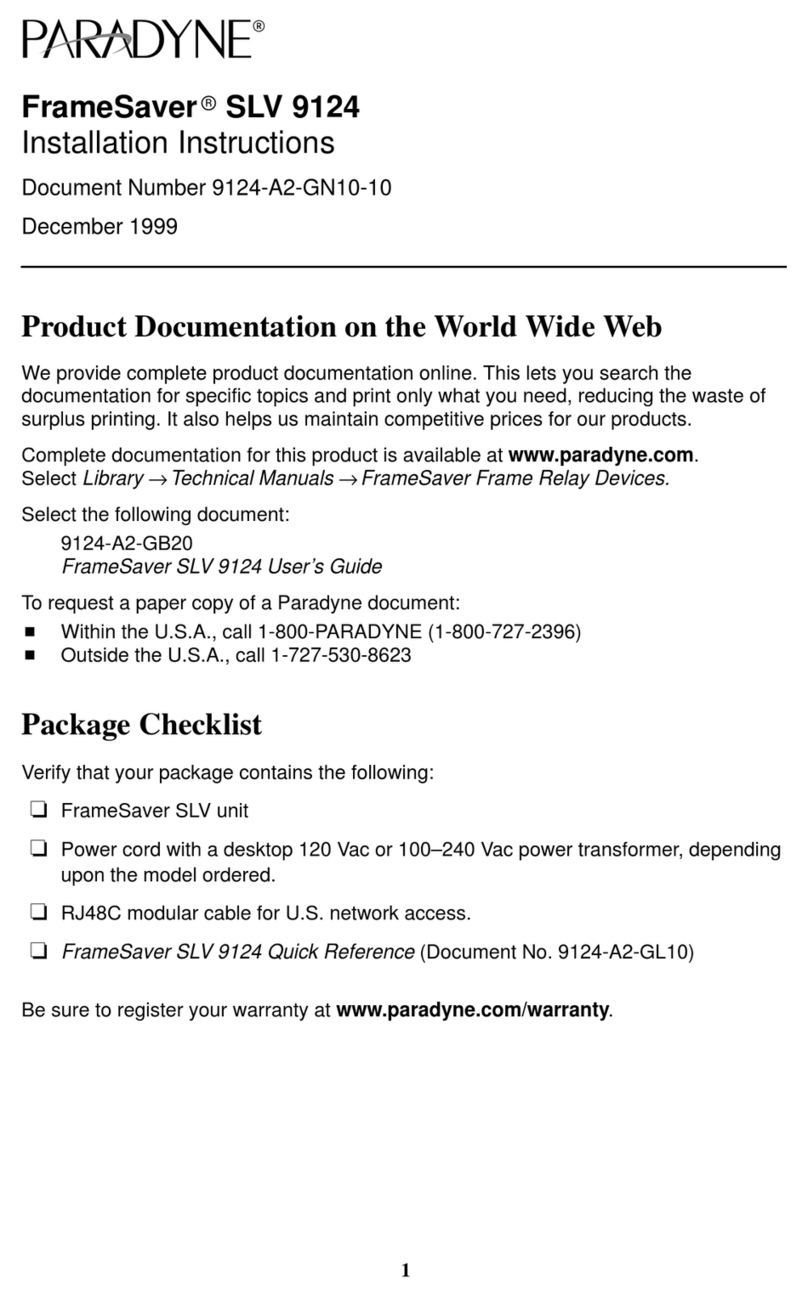
Paradyne
Paradyne FrameSaver SLV 9124 installation instructions
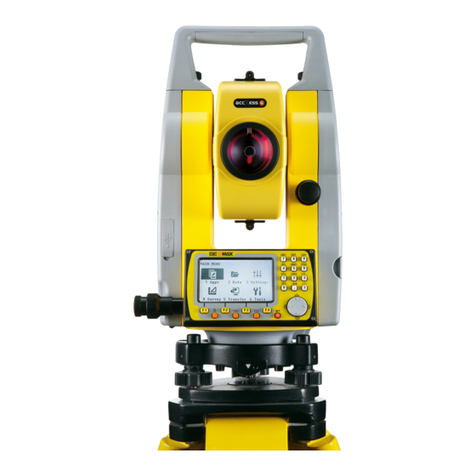
GeoMax
GeoMax Zoom20 Pro Series user manual
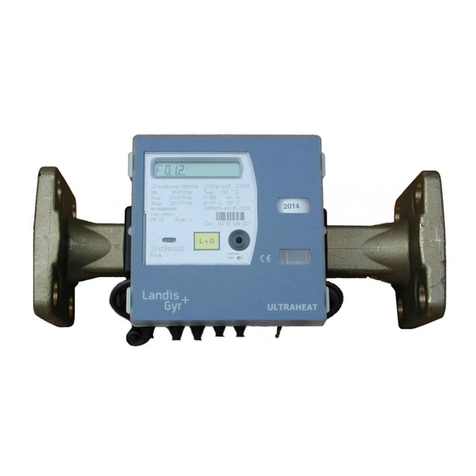
Landis+Gyr
Landis+Gyr 2WR5 operating instructions
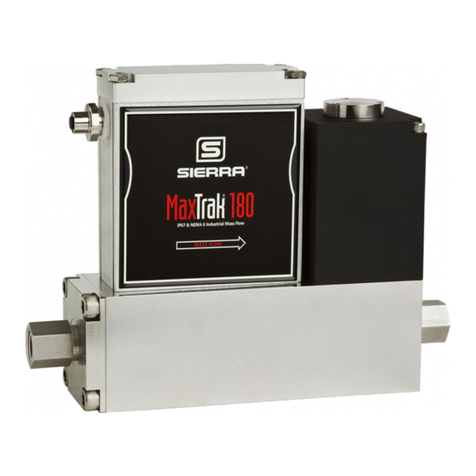
Sierra
Sierra MaxTrak 180 Series quick start guide
